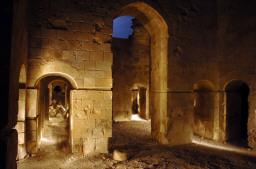One of Italy's top cultural events will go on show in Florence this summer, exploring a Middle East flashpoint region at the time of the Crusades.
Opening in mid-July, the exhibit will showcase over 100 artefacts unearthed during a 20-year archaeological project by Florence University.
The focal point of the show is Montreal Castle, known as Shobak in Arabic and Shawbak in Italian, located in a Jordanian section of the Great Rift Valley.
Clinging to the side of a rocky mountain, the castle was built in 1115 by the French Crusader Baldwin I of Jerusalem during his expedition to the area.
The castle had collapsed into a heap of ruins by the time the Italian-Jordanian archaeological project began there 20 years ago but the excavations have revealed it was once the heart of a strategic region between the two great powers of Egypt and Syria.
The artefacts pulled from the rubble have made this one of the most fascinating large-scale sites in the Eastern Mediterranean, offering experts considerable insight into trade and life at the time.
The castle was strategically located on the pilgrimage and caravan routes between Syria and Arabia, giving it control of all local commerce.
After a two-year siege ending in 1189, the European occupants were ousted and the castle fell into the hands of Saladin as part of the successful Muslim campaign he led against the Crusaders.
Although the focus will be on Montreal Castle, the exhibition will also explore the region's history at the time of the Crusades through finds unearthed at Petra.
Designated a UNESCO World Heritage Site in 1985, the Jordanian site is internationally renowned for its wealth of rock-cut architecture.
Organizers of the exhibition, a joint project with Jordan's Department of Antiquities, said they had deliberately decided to limit the number of pieces on display in order to spotlight finds of particular significance.
The selection comes from a number of sources: the Florentine archaeological mission in Jordan, Jordanian national museums and international excavations in the area.
There will also be a small but important contribution from Florence's collection of Islamic art.
Among the items on display will be column decorations in the shape of elephants, pottery, effigies and utensils, as well as a key inscription from the Roman settlement of Augustopolis, uncovered just 18 months ago.
The exhibition is entitled 'Da Petra a Shawbak. Archeologia di una frontiera' (From Petra to Montreal Castle. The Archaeology of a Border Region') and is on show at Palazzo Pitti from July 13 until October 19.





